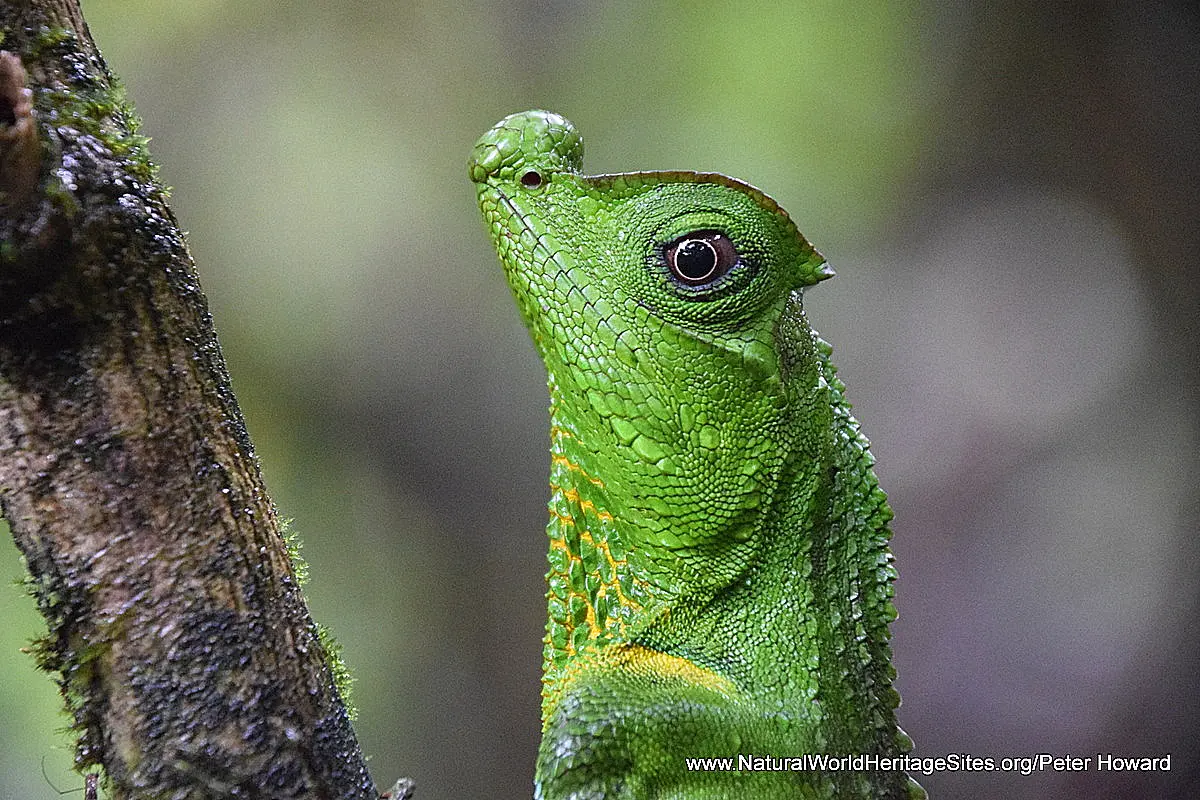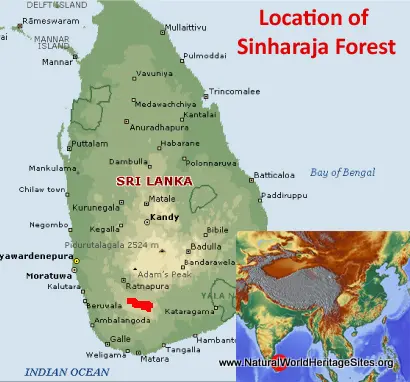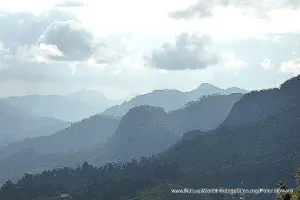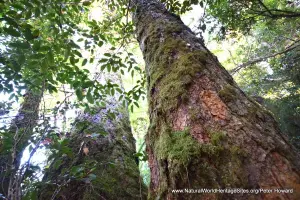EXPLORE THE SINHARAJA FOREST RESERVE with this slideshow, check the location map and get all the facts and information below.
For slideshow description see right or scroll down (mobile). Click to view slideshow
Location and Values: Sinharaja Forest Reserve is situated in the south-west lowland wet zone of Sri Lanka, ranging in altitude from 300 to 1,170m. Although it is a comparatively small area (89 km2), it is important as one of the last remaining fragments of (relatively) undisturbed lowland forest in Sri Lanka, providing habitat for a high proportion of the island’s unique fauna and flora. For example, Sinharaja supports more than 90% of Sri Lanka’s 26 endemic bird species, and 75% of the country’s 20 endemic mammals. Many of the tree species protected within this small reserve are highly threatened by forest destruction elsewhere on the island, so Sinharaja represents the ‘best chance’ to ensure their long-term conservation. Sixty percent of the tree species recorded at Sinharaja is found only in Sri Lanka, while more than 90% of its Dipterocarp trees are endemic to the island. New discoveries are still being made, but existing knowledge clearly demonstrates the importance of Sinharaja for the conservation of Sri Lanka’s endemic fauna and flora, including especially large numbers of unique reptiles, amphibians, freshwater fish, invertebrate animals and plants such as ferns and orchids.
Conservation Status and Prospects. According to IUCN’s Conservation Outlook Assessment (2017) the conservation status of Sinharaja Forest Reserve is of ‘significant concern’. The IUCN report notes that ‘ The value of Sinharaja as a natural world heritage site continues to be recognized by the discovery of several endemic species of plants and animals since the declaration of this forest as a world heritage in 1988. Some of the recent discoveries include several species of herpetofauna that are restricted (‘point endemic species’) to the eastern region of Sinharaja. These findings are a result of well-planned systematic research work carried out in Sinharaja over the past three decades. The site is an icon of biodiversity conservation in Sri Lanka, which has led to a considerable increase in conservation awareness among the general public. However, existing conservation issues such as encroachment of forest due to agricultural expansion (e.g., tea plantations), human dwellings and fragmentation due to road construction could seriously compromise the conservation of the world heritage site in the future. The management authority needs to take immediate steps, including preparation of an updated management plan in consultation with pertinent stakeholders, and implementation of a plan of action to address threats and fill management gaps. It is expected that some of these concerns can be addressed through two recently initiated projects – National REDD+ Investment Framework and Action Plan (NRIFAP) and the World Bank funded Ecosystem Conservation and Management Plan (ESCAMP).’
Links:
Google earth
Official UNESCO Site Details
IUCN Conservation Outlook
UNEP-WCMC Site Description
Birdlife IBA
Slideshow description
The slideshow is intended to ‘tell the story’ of the Sinharaja Forest Reserve, and features a portfolio of photos from a visit by Peter Howard in October 2017. The visit was centred around Kudawa in the north-west of the reserve and the slideshow begins with some views of the forest edge and adjacent agricultural lands where tea plantations occupy the hillsides and lowland rice paddies fill the valley bottoms. At the entrance to the Forest Reserve there is a double-storey wooden building – the Kudawa Conservation Centre – with maps and poster displays of some of the attributes of the forest, where ticket sales and (compulsory) guides are available. A small pond adjacent to the centre provides an opportunity to get close-up views of some of the endemic amphibians (frogs) and reptiles, and careful observation may reveal one of the endemic Sri Lankan green pit vipers lurking in the nearby vegetation. Many species found around here, including fish, orchids, dragonflies and snails are unique to the island of Sri Lanka, and many are endemic to much smaller areas, including some species that are known only from specific parts of Sinharaja forest.
From the entrance gate various trails lead into the forest, all quite short and local to the Kudawa area. Leeches are very abundant and a significant deterrent to straying off the path, even if you are wearing leech-proof leggings! And there are other dangers for the unprepared – the giant webs of golden orb-web spiders and a small population of Sri Lanka’s endemic sub-species of leopard. There are just three elephants surviving in this small forest, no longer a viable population but enough to instill a deep sense of fear amongst tourist guides and local community members. Hump-nosed lizards may be encountered, motionless as they cling to vertical stems in the forest understorey, and (hidden beneath a dense clump of undergrowth) a pair of roosting Sri Lanka frogmouths. Other species shown here include giant squirrel and jungle fowl, as well as the cryptically-coloured (endemic) Sri Lanka kangaroo lizard amongst the fallen leaves on the forest floor, and the equally well-camouflaged Sri Lankan blue oak leaf butterfly. One of the forest trails leads to a giant ‘Nawada’ tree, while another ascends through dense forest to Mulawella peak (760m) with its rocky summit and clear far-reaching views across the forest canopy. Here some of Sri Lanka’s endemic palms can be clearly seen, and along the trail areas of Dipterocarp forest with the characteristically tall straight trunks of these trees. Twisted liannes and stilt roots are familiar elements of the rainforest, and forest streams support their own aquatic communities of species, many unique to Sri Lanka. The slideshow ends with a chance sighting of a solitary purple-faced langur, one of the island’s endemic forest monkeys.
Factfile
Website Category: Tropical & Sub-tropical Forests;
Area: 89 km2
Inscribed: 1988
Criteria:
- Ecological processes (ix);
- Natural habitat for biodiversity (x);
- Significant number of rare, endemic and/or endangered species (x)





